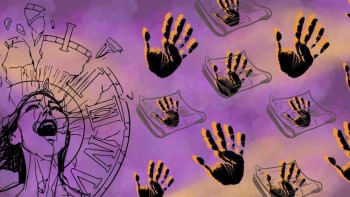Pain, bleeding and helplessness: Living with fibroids and cysts

The world as we know it is full of inequalities. Some are more detrimental than others, like the glaring inequity in the research fields of women's and men's health.
Medical treatment is a basic need and women are different from men in many ways, including physiologically. Women's cardiovascular health, hormonal balance, mental health, musculoskeletal health, immune system, metabolism, and last but not least, reproductive health, are different from those of men. For instance, with heart attacks, the most common symptom in both men and women is chest pain. However, women are often more likely to experience other symptoms, such as shortness of breath, nausea or vomiting, or jaw pain. Women and men also metabolise and respond to many drugs differently. There are also gender-based variations in the physiological mechanisms underlying pain.
However, even though women make up close to 50 percent of the world's population, there is a glaring lack of research on their health.
This historical focus on the "default" male body sidelines conditions predominantly affecting women such as uterine fibroids—non-cancerous growths on or in the uterus, and ovarian cysts—sacs filled with fluid that form on or inside an ovary. Is this oversight just a scientific failure? No, it is also a social injustice with deep, multifaceted implications.
Some claim that an estimated 171 million women worldwide have uterine fibroids. Another source indicates global prevalence has increased from 126.41 to 226.05 million cases in recent decades.
On the other hand, an ovarian cyst is a widespread phenomenon in women of reproductive age. Among the people I know closely, seven women are combating this problem in various stages. The number will be eight if I count myself. So, even though I failed to collect information on the number of cases worldwide, again due to the lack of research in this area, I know that the number is very high.
These conditions hamper the quality of life with their debilitating symptoms—painful periods, heavy and inconsistent bleeding, unmanageable cramps, chronic pelvic pain, bloating and swelling, back and leg pain, constipation and diarrhoea, anaemia, etc. Along with these, stress and feelings of helplessness stem from lack of options.
So, who develops cysts and fibroids and why? Can they be prevented? You guessed the answer correctly. We do not know what leads to the development of these unwanted growths, nor is there any prevention. To date, no long-term or non-invasive treatment option exists for uterine fibroids or pathological ovarian cysts. All you can do is be vigilant and regularly visit your sonographer and gynaecologist, hoping to catch them early so you don't need to go to the operating table.
The consequences of this imbalance in the medical research sector are stark. Without sufficient research, the pathogenesis and preventive strategies for these common yet debilitating conditions remain poorly understood, resulting in women suffering through cycles of pain, fertility issues, and diminished quality of life.
The lack of preventive measures for fibroids and ovarian cysts means that treatment is reactive rather than proactive—addressing symptoms after significant damage has been done. This reactive approach not only burdens the healthcare system but also places an emotional and physical toll on millions of women, whose reproductive health is sidelined in favour of conditions deemed more "urgent" or "universal."
The situation is even more pronounced in the Indian subcontinent, where patriarchal norms and socio-cultural taboos further hinder open discussions about women's health.
Bangladesh faces unique challenges: a high population density, widespread poverty, and a healthcare system stretched thin by infectious diseases and maternal health emergencies.
These pressing concerns, while critical, have often crowded out the nuanced research and measures needed for chronic conditions like fibroids and ovarian cysts. Moreover, the stigma attached to discussing menstrual irregularities or pelvic pain further discourages women from seeking medical advice until conditions have advanced, thereby complicating treatment and outcomes.
Obstetrician-gynaecologist (OB-GYN) Dr Ferdousi Begum, a professor of the Bangladesh Institute of Research and Rehabilitation in Diabetes, Endocrine and Metabolic Disorders (BIRDEM) Hospital, said that there has only been sporadic and small-scale research in this area in Bangladesh, which is not nearly enough.
In developing countries, including Bangladesh, funding for research on women's health is much less in proportion to other fields, she said, adding that more research in the area can assist doctors in helping the patients in newer ways.
Women's reproductive health is still a taboo in many households. Fibroids and cysts are often diagnosed late when the only available treatment left is surgery, she said.
Pain and excessive bleeding during periods should not be ignored as these can be symptoms of cysts and fibroids, the OB-GYN said. In case of recurrent fibroids, which is fairly common, doctors sometimes suggest removing the uterus. However, this option is not for those who want to conceive. However, fibroids and cysts (which are also likely to recur) may cause infertility as well.
Establishing powerful genetic labs in Bangladesh is one of the steps required to address the lack of research in the medical sector, including in women's health, she said. There are only a few such labs in the country—that too in private capacity, she added.
Research about ovarian cysts and fibroids is at the intersection of healthcare equity. More research and better treatment are also necessary for society and the economy. Ovarian cysts and fibroids cost women, their families, and businesses hundreds of thousands in lost work hours and medical procedures.
Sifat Afrin Shams is a member of the editorial team at The Daily Star.
Views expressed in this article are the author's own.
Follow The Daily Star Opinion on Facebook for the latest opinions, commentaries and analyses by experts and professionals. To contribute your article or letter to The Daily Star Opinion, see our guidelines for submission.

 For all latest news, follow The Daily Star's Google News channel.
For all latest news, follow The Daily Star's Google News channel. 











Comments